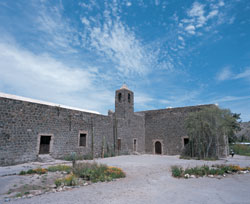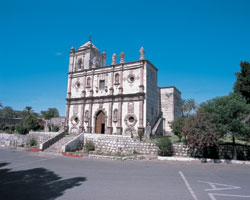Between the desert and the oasis:
The Baja California Sur Missions
By: Margarita Sepúlveda Amor
 These
distant lands were conquered as a result of the unshakable resolve and
tireless efforts of a group of Jesuit missionaries who, knowing that
the conquistadors, had been unable to subdue the Indians, decided to
evangelize them, in the hope that words would succeed where weapons
had failed.
These
distant lands were conquered as a result of the unshakable resolve and
tireless efforts of a group of Jesuit missionaries who, knowing that
the conquistadors, had been unable to subdue the Indians, decided to
evangelize them, in the hope that words would succeed where weapons
had failed.
Thus it was that in the late 17th century, under the enthusiastic leadership of the Jesuit Eusebio Kino, who had obtained permission from the Spanish authorities to join the expedition of Admiral Isidro Atondo y Antillón, the missionaries arrived in what they thought was an island, to evangelize its indomitable inhabitants. The Crown had given its authorization on condition that the Conquest be carried out in the name of the King of Spain, and that the missionaries themselves obtain the funds for undertaking the enterprise.
 The
first mission, Santa María de Loreto, was founded in 1697 by another
Jesuit, José María Salvatierra, who had been in the Sierra
Tarahumara, and whom Father Kino had encouraged to embark on this enormous
task. For over a hundred years, this mission was the political, economic
and religious capital of both Californias.
The
first mission, Santa María de Loreto, was founded in 1697 by another
Jesuit, José María Salvatierra, who had been in the Sierra
Tarahumara, and whom Father Kino had encouraged to embark on this enormous
task. For over a hundred years, this mission was the political, economic
and religious capital of both Californias.
Over the next three quarters of a century, the missionaries founded a chain of eighteen missions, magnificent fortresses linked by the “royal road” that they themselves built, connecting the Los Cabos region in the south of the peninsula, to the current border with the US. This was possible because among the missionaries there were chaplains with knowledge of construction and hydro-engineering, whose works made it possible to provide water for desert areas.
 Some
of these formidable constructions have been preserved in perfect condition,
such as the Misión de San Ignacio, one of the best preserved and
beautiful of Baja California Sur, built by Father Juan Bautista Luyando
in 1728; and the Misión de San Francisco Javier, founded in 1699,
consisting of a simple adobe chapel and rectory built by Fr. Francisco
María Piccolo. The current building was erected in 1774 by Father
Miguel Barco and its stunning architecture has earned it the title of
“the jewel of the Baja California Sur missions”. Santa Rosalía
de Mulegé, now the Mulegé community, was established in
1705 by Father Juan María Basaldúa, 117 kilometers north
of Loreto. It had one of the best locations, since it was built in an
oasis next to the sea, and combined superb architecture, rich decoration,
and magnificent altarpieces and paintings with practical surroundings,
which enabled permanent towns to be established around it. The missionaries
not only evangelized the Indians but took them cattle, taught them how
to make the desert bloom with date palms, introduced the cultivation of
corn, wheat and sugarcane and made the earth produce fruit trees such
as avocado and fig. In order that they could perform their religious rites
that required wine and oil, they obtained permission to cultivate vines
and olive trees, which was forbidden in the rest of New Spain, and as
a result of which the region now produces excellent wines and olive oil.
And on top of all that, they introduced the first rose bushes that flourished
in these lands and now grace parks and gardens throughout the peninsula.
Some
of these formidable constructions have been preserved in perfect condition,
such as the Misión de San Ignacio, one of the best preserved and
beautiful of Baja California Sur, built by Father Juan Bautista Luyando
in 1728; and the Misión de San Francisco Javier, founded in 1699,
consisting of a simple adobe chapel and rectory built by Fr. Francisco
María Piccolo. The current building was erected in 1774 by Father
Miguel Barco and its stunning architecture has earned it the title of
“the jewel of the Baja California Sur missions”. Santa Rosalía
de Mulegé, now the Mulegé community, was established in
1705 by Father Juan María Basaldúa, 117 kilometers north
of Loreto. It had one of the best locations, since it was built in an
oasis next to the sea, and combined superb architecture, rich decoration,
and magnificent altarpieces and paintings with practical surroundings,
which enabled permanent towns to be established around it. The missionaries
not only evangelized the Indians but took them cattle, taught them how
to make the desert bloom with date palms, introduced the cultivation of
corn, wheat and sugarcane and made the earth produce fruit trees such
as avocado and fig. In order that they could perform their religious rites
that required wine and oil, they obtained permission to cultivate vines
and olive trees, which was forbidden in the rest of New Spain, and as
a result of which the region now produces excellent wines and olive oil.
And on top of all that, they introduced the first rose bushes that flourished
in these lands and now grace parks and gardens throughout the peninsula.
Source: Tips Aeroméxico # 24 Baja California Sur / summer 2002
| |